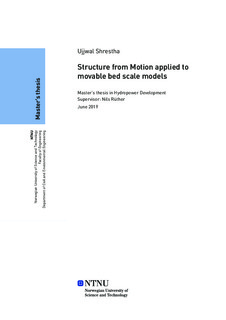| dc.description.abstract | Many spatial data collection methods are available for a physical hydraulic model study considering mobile bed sediment. Some of them are highly sophisticated and advanced, which provide high-quality results in a shorter time. But they come with high capital and logistical cost and requires special training for execution. Whereas, the conventional surveying methodology, which is simple and inexpensive, require plenty of time for the measurement and processing of the data, provides a very low-quality data in comparison. That is why the recent developments in ‘Structure from Motion’ (SfM) technique have made it a potential candidate for an inexpensive and efficient tool for measurement of bed morphology in physical hydraulic model studies.
SfM method allows to simultaneously determine both the parameters of the camera and the 3-D structure of a scene by combining 2-D images taken from multiple viewpoints. It can create a dense point cloud out of a set of overlapping images taken even by a budget-friendly digital camera or a smartphone and freely available SfM software. The SfM method has already been used as an alternative for topographic surveying to create high-resolution digital elevation models (DEM). Some researchers have also used it for measurement of bed morphology in laboratory experiments.
In this study initially a low-cost tool SfM was introduced and applied in movable bed scale models to illustrate the potential of SfM applications in physical hydraulic models. Then six different SfM tools were chosen for the study and were used to create 3-D models of a physical hydraulic model. The cross-sections from the 3-D output were compared with the manual cross-section measurements. From this comparison a commercial SfM tool ‘Agisoft PhotoScan’ was chosen for further application in hydraulic models.
Two hydraulic models, one river model without any hydraulic structures and another having headworks structure components were chosen for the study. Firstly, SfM tool ‘Agisoft PhotoScan’ was applied to study the bed evolution in a physical river model at high sediment transport. The volume change in a certain reach of the river was estimated. Also, the cross-sections were compared with manual measurements done through a conventional surveying technique using a theodolite and a level machine. The accuracy of the output was compared with the manual measurement of length, cross-sections and sediment volume. Lastly, it was used to study the overall performance of headworks and trace the sediments in a model containing complex flushing hydraulic structures. Also, the flushed volume in certain flow and flushing mechanism was estimated and compared with manual volume measurement of flushed sediments.
The results conclude that SfM technique, in particular, Agisoft PhotoScan can be used as an inexpensive and efficient alternative for bed morphology measurements in physical hydraulic models with higher accuracy. | |
